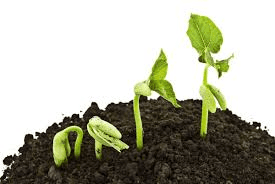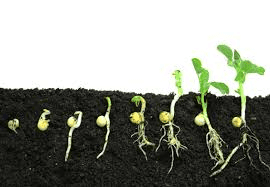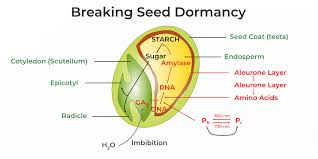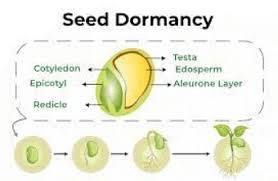With the seed germination, the independence of the next generation of plants begins. Seeds have to germinate and get established to produce the next set of seeds. Nature has it that there are different periods allowed for seeds to initiate the process of germination.
The failure of an intact viable seed to complete germination under favourable condition is what is called dormancy. These two critical phenomena of seed dormancy and germination are controlled by factors which will be elucidated in this article.
Seed Germination

Every seed contains an embryo which is the new plant in miniature. It is structurally and physiologically equipped for its role as it is well provided with enough food reserves to sustain the growing seedling until it establishes itself as a self-sufficient, autropic organism.
Germination commences with the uptake of water by the dry seed-imbibitions, and is completed when a part of the embryo, usually the radicle, extends to penetrate the structures that surround it.
Uptake of water by a mature dry seed is in three phases. Phase one is with a rapid initial uptake followed by a plateau phase (phase two).
The third phase will only take place with further uptake of water only after germination is completed, as the embryonic axes elongate. Because dormant seeds do not complete germination, they cannot enter phase three.
The influx of water into the cells of dry seeds during phase one results in temporary structural perturbations, particularly to membranes, which lead to an immediate and rapid leakage of solutes and low molecular weight metabolites into the surrounding imbibition solution.
Upon imbibition, the quiescent dry seed rapidly resumes metabolic activity. The structures and enzymes necessary for this initial resumption of metabolic activity are generally assumed to be present within the dry seed, having survived, at least partially intact, the desiccation phase that terminates seed maturation.
Reintroduction of water during imbibition’s is sufficient for metabolic activities to resume, with turnover or replacement of components occurring over several hours as full metabolic status is achieved.
The time for events to be completed varies from several hours to many weeks, depending on the plant species and the germination conditions.
With few exceptions, radicle extension through the structures surrounding the embryo is the event that terminates germination and marks the commencement of seedling growth.
Conditions for Germination

Several factors influence seed germination. They include:
External factors such as water, oxygen and suitable temperature
Internal factors such as seed dormancy due to internal conditions
Water is crucial to seed germination. A dormant seed is generally dehydrated and contains hardly 6-15% water in its living cells.
The active cells, however, require about 75-95% of water for carrying out their metabolism. Therefore, the dormant seeds must absorb external water to become active and show germination.
Read Also : Role of Environmental Resources to Plant Growth and Development
Besides providing the necessary hydration for the vital activities of protoplasm, water softens the seed coats, causes their rupturing, increases permeability of seeds, and converts the insoluble food into soluble form for its translocation to the embryo.
Water also brings in the dissolved oxygen for use by the growing embryo. The seed must go through imbibition to activate root growth. However, too much water can be harmful to a germinating seed.
When a plant is still growing underground, during root formation, it relies on the stored food inside the seed, and oxygen from the environment to make energy. If the soil is too saturated with water, there will not be enough oxygen for the plant to survive.
Temperature is also an important factor. Moderate warmth is necessary for the vital activities of protoplasm. Some seeds germinate when it is cold, while others only germinate when the weather reaches warm temperatures.
Other seeds only germinate after extreme temperatures, such as after a fire in the grasslands. Though germination can take place over a wide range of temperature (5-40°C), the optimum for most of the crop plants is around 25-30°C. The germination in most cases stops at 0°C and 45°C.
Oxygen is necessary for respiration which releases the energy needed for growth. Germinating seeds respire very actively and need sufficient oxygen. The germinating seeds obtain this oxygen from the air contained in the soil.
It is for this reason that most seeds sown deeper in the soil or in water-logged soils (i.e. oxygen deficient) often fail to germinate due to insufficient oxygen. Ploughing and hoeing are cultural methods that aerate the soil and facilitate good germination.
Seed dormancy due to internal conditions. In some plants the embryo is not fully mature at the time of seed shedding. Such seeds do not germinate till the embryo attains maturity.
The freshly shed seed in certain plants may not have sufficient amounts of growth hormones required for the growth of embryo. These seeds require some interval of time during which the hormones get synthesized.
The seeds of almost all the plants remain viable or living for a specific period of time. This viability period ranges from a few weeks to many years. Seeds of Lotus have the maximum viability period of 1000 years.
Seeds germinate before the ending of their viability periods. In many plants, the freshly shed seeds become dormant due to various reasons like the presence of hard, tough and impermeable seed coats, presence of growth inhibitors and the deficiency of sufficient amounts of food, minerals and enzymes, etc.
Seed Dormancy

Seed dormancy is generally an undesirable characteristic in agricultural crops, where rapid germination and growth are required. However, some degree of dormancy is advantageous, at least during seed development.
This is particularly true for cereal crops because it prevents germination of grains while still on the ear of the parent plant (pre-harvest sprouting), a phenomenon that results in major losses. Thus, dormancy is an adaptive trait that optimizes the distribution of germination over time in a population of seeds.
Crop species have ostensibly removed most dormancy mechanisms present in the seeds of their wild ancestors, although under adverse environmental conditions, dormancy may reappear.
By contrast, weed seeds frequently mature with inherent dormancy mechanisms that allow some seeds to persist in the soil for many years before completing germination.
Virtually all the cellular and metabolic events that are known to occur before the completion of germination of non-dormant seeds also occur in imbibed dormant seeds; indeed, the metabolic activities of the latter are frequently only subtly different from those of the former.
Hence, a dormant seed may achieve virtually all of the metabolic steps required to complete germination, yet for some unknown reason, the embryonic axis (i.e., the radicle) fails to elongate.
What is Dormancy?

Despite the fact that many researchers study dormancy, there is no unambiguous definition of the phenomenon, perhaps because it is manifest and broken in different ways in different species.
For the sake of simplicity, seed dormancy is regarded here as the failure of an intact viable seed to complete germination under favourable conditions.
Read Also : How to treat Ruminant Animal Diseases
The seeds of some species are prevented from completing germination because the embryo is constrained by its surrounding structures. This phenomenon is known as coat enhanced dormancy; embryos isolated from these seeds are not dormant.
In other species, a second category of dormancy is found in which the embryos themselves are dormant (embryo dormancy). Since dormancy is regulated at different developmental phases, in interaction with environmental factors, it is difficult to detect when the genetic and physiological differences are established.
This difficulty arises because all dormancy assays are based on seed germination, which is the result of the balance between the degree of dormancy and the capacity of the embryo to overcome dormancy.
Importance of Seed Dormancy
There are advantages of dormancy in agriculture. These include:
Perennation: Seed dormancy allows seeds to pass through drought, cold and other unfavourable conditions.
Dispersal: It is essential for dispersal of seeds. The period of dormancy of seed is essential for seeds to be found in other locations, thus help in the natural distribution process.
Germination under favourable conditions: Seeds germinate only when sufficient water is available to leach out inhibitors and soften the seed coats.
Where the conditions for germination are not favourable, the seed remains intact, thus prolonging their self- life.
Dormancy under this condition has helped in the study of the conditions necessary for germination.
Storage: It is because of dormancy that human beings are able to store grains, pulses and other edibles for making them available throughout the year and transport to the areas of shortfall or where there are better prices for these crops.
Breaking of Seed Dormancy
There are two types of breaking seed dormancy, natural and artificial. In nature seed dormancy is broken automatically due to:
Development of growth hormones to counter growth inhibitors,
Leaching of germination inhibitors,
Maturation and after-ripening of embryo
Weakening of impermeable and tough seed coats by microbial action, abrasion, passage through digestive tract of animals, etc.
Artificial Breaking of Seed Dormancy involves:
Scarification: Hard, impermeable seed coat is weakened or ruptured by filing, chipping, hot water and chemical treatments.
Stratification: Seeds are moistened and exposed to oxygen for variable period at low or high temperature. There is also mechanical stratification e.g. the use of sandpaper, hammer, and knife.
Counteracting Inhibitors: Inhibitors are destroyed by dipping seeds in KNO3, thiourea, ethylene chlorohydrin and gibberellin.
Shaking and Pressure: Vigorous shaking and hydraulic pressure are used to weaken seed coats.
In summary, with the seed, the independence of the next generation of plants begins. Because the function of a seed is to establish a new plant, it may seem peculiar that dormancy, an intrinsic block to germination, exists. But it may not be advantageous for a seed to germinate freely, even in seemingly favourable conditions.
Seed dormancy is generally an undesirable characteristic in agricultural crops, where rapid germination and growth are required. However, some degree of dormancy is advantageous, at least during seed development.
Read Also : Soya Milk: Nutrition, Facts and Health Benefits
Frequently Asked Questions
We will update this section soon.
